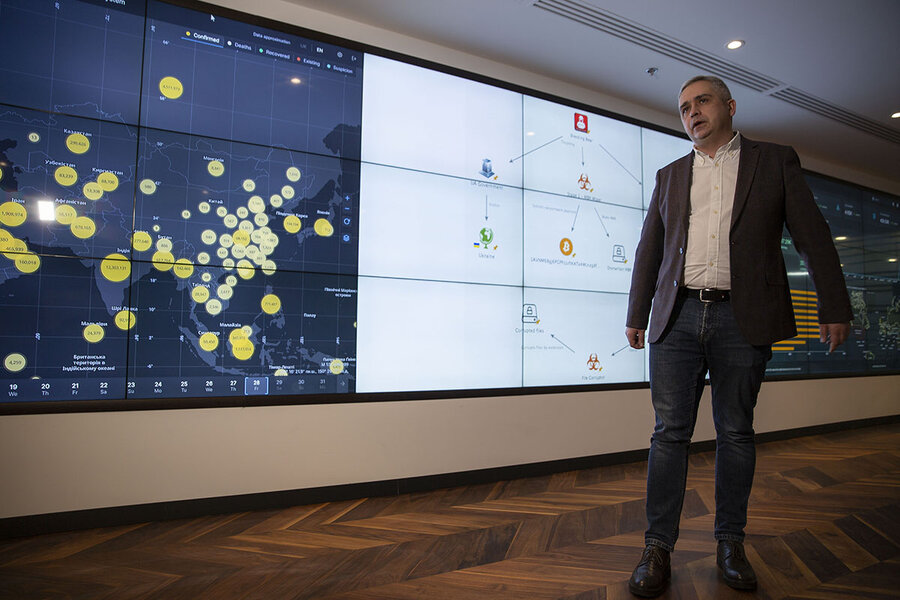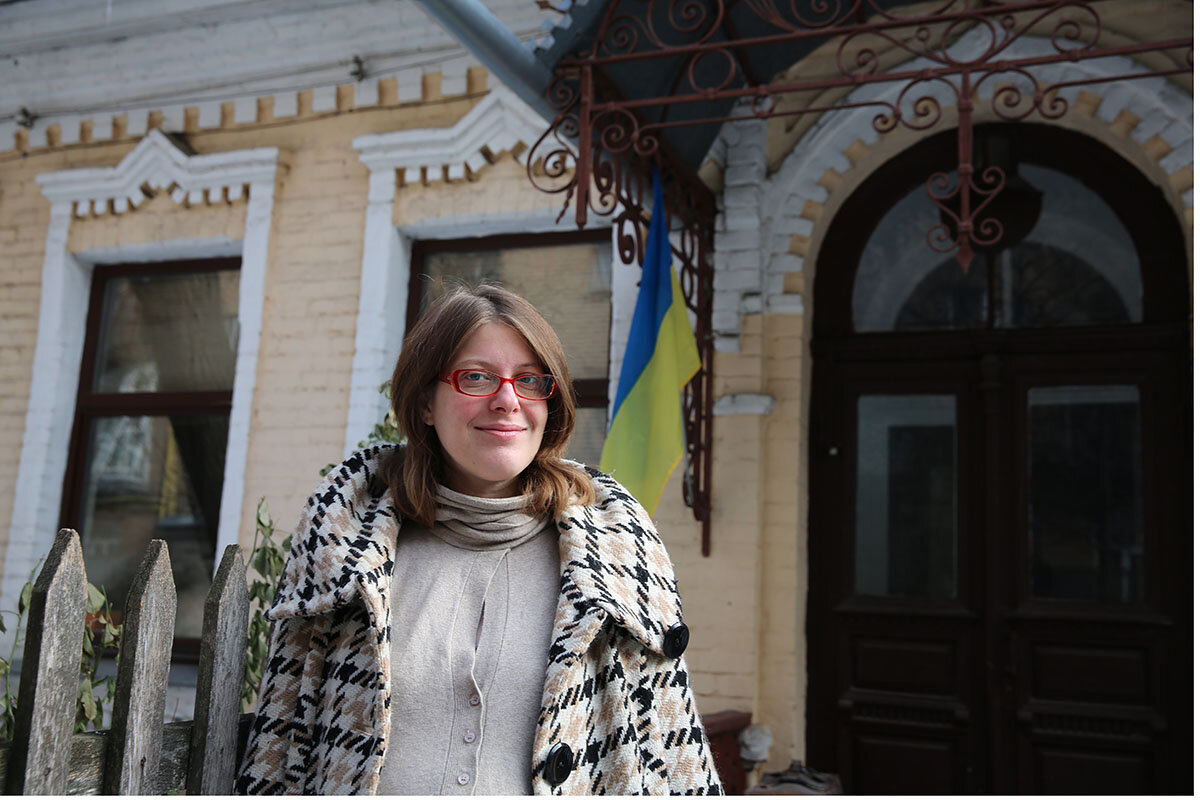Ukraine battles another Russian threat: Misinformation
Loading...
| Kyiv, Ukraine
The United States worries a false flag attack against Russia, supposedly by Ukraine, will be used by Moscow to justify an invasion. British intelligence frets over a coup plot that would put a pro-Kremlin government in Kyiv.
For those on the front lines of Ukraine’s information war with Russia, these tropes are deeply familiar. They go back to when Russia annexed Crimea and Moscow began a multipronged campaign against Ukraine.
“Russia propaganda tries to persuade the world and their own population that Ukraine is preparing an offensive against Donbass [the pro-Russian rebel regions in eastern Ukraine] or against Russia, and that Russia has a legal and moral right to start their own offensive in response to the actions of the Ukrainian government,” says Ruslan Deynychenko, executive director of StopFake.org, a Ukrainian fact-checking website.
Why We Wrote This
Ukraine isn’t dealing just with Russian troops on its borders. It also faces a constant misinformation campaign targeting the hearts and minds of Ukrainians that it is struggling to manage.
“The disinformation that we observed in 2014 is pretty much the same as the one we see right now,” he says. The parallels in tone and volume of disinformation efforts then and now – buttressed both by official statements and crude “fake” videos circulated on social media – trouble Mr. Deynychenko. He and his team are working round-the-clock to promote media literacy and debunk false information circulated by pro-Kremlin media.
Russia’s strategy in Ukraine is best summed up as “hybrid warfare.” The toolkit is varied, mixing conventional warfare with propaganda, disinformation, misinformation, fakes, front political movements and parties, and cyberattacks.
With international tensions running high around the possibility of a Russian invasion of Ukraine, the country’s counter-misinformation efforts have a renewed sense of urgency. For even as Russian troops amass along Ukraine’s borders, Moscow is laying out a propagandist case to win over Ukrainians, via persuasion or misinformation, to its own way of thinking, Western experts say. And that could shape the outcome of an invasion just as much as conventional arms.
“This is all part of a broader, orchestrated campaign against Ukraine and also against the West, to show that ‘Ukraine is our sphere of influence,’” EU foreign affairs spokesperson Peter Stano says. Russian President Vladimir “Putin is escalating this. Until recently, it was only disinformation and cyberattacks, but now he is also using real military force.”
“The main battle space is not on the ground”
The threat of conflict is serious enough that civilians across Ukraine have packed emergency kits or sacrificed their weekends to train for a possible attack. NATO boosted its forces in Eastern Europe – the U.S. has ordered an additional 6,000 troops to Romania and Poland this month. That pales in comparison with the 130,000 troops Russia deployed around Ukraine.
There was not this much military posturing before the annexation of Crimea and subsequent establishment of two pro-Russian statelets in Ukraine’s Donbass region in 2014. That’s part of the reason that experts in Kyiv say such a public show of force by Russia has more complex motives.
“The military part is actually a very small part of Russia’s hybrid war,” says Alya Shandra, editor-in-chief of Euromaidan Press, an internet-based English-language newspaper named after the 2013 pro-European protests that overturned a government more closely aligned with Moscow.
“The main battle space is not on the ground,” she says. Ms. Shandra has studied thousands of Russian official communications on Ukraine that were leaked by Ukrainian hackers in 2016-17. “It’s in the mind. All these troop movements aim to create a picture in our minds, so we think a certain way and then behave a certain way.”
Countering Russia’s mind games is as essential as countering its military moves, she argues. And not just for the sake of Ukraine, as many tactics the Kremlin tests on its neighbor are later used against the West.
Many believe the short-term goal of the buildup is to get concessions from the government in Kyiv and from NATO, the Western military alliance that Ukraine would like to join. All the saber rattling has certainly been terrible for Ukraine’s economy. The long game is bringing Ukraine back under the control of Moscow.
“It’s not a conventional war like the wars of the 19th or 18th century where a country would just invade and occupy a part of another country,” adds Ms. Shandra. “It’s something larger that has the ultimate goal of drawing Ukraine back into the Russian sphere of influence, by force, by trickery, by coercion, by persuasion, by different means.”
These strategies took shape during the Soviet Union when the goal in Moscow was to spread communism across the world. Because the Soviet Union was weaker than the West, it had to rely on trickery, she argues. That context spawned “reflexive control theory,” a term coined by Vladimir Lefebvre. The Soviet equivalent of game theory, reflexive control theory is, at its essence, the art of manipulating opponents into acting in your (or in this case, Russia’s) best interest.
“It takes just five minutes to produce a fake”
Russia has already “succeeded” in getting some of what it has wanted, Ms. Shandra says. Its power posturing around Ukraine allowed it to secure a meeting with U.S. President Joe Biden and demand an end to NATO’s expansion of the last few decades.
And it has presented a real threat to Ukraine, which the West must take seriously. “We shouldn’t underestimate the possibility for Putin to intervene [in Ukraine],” says Olexiy Haran, professor of comparative politics at the National University of Kyiv-Mohyla Academy. “Putin is testing the West, to see to what extent the West will be firm.”
It also appears to have had some success in winning over Ukrainians to its perspective. A December poll found that 30.3% of respondents in Ukraine wish to do away with the country’s “external governance” by the West and 25% wish to restore economic ties with Russia.
“Putin is saying, ‘Let’s make Ukraine neutral, non-bloc,’” points out Mr. Haran. “We were non-bloc before 2014. Nevertheless, Putin attacked us.”
That makes Ukrainian defenses all the more important.
Some of those are virtual. Serhiy Prokopenko, head of the National Coordination Center for Cybersecurity at the National Security and Defense Council Staff of Ukraine, says there has been increased Russian-suspected cyberactivity since October. While not all of them become public, cyberattacks have become larger, more targeted, and more complex. The Russian threat “is constant” as these cyber operations are an integral part of Russia’s hybrid war, but Ukraine has learned from experience.
“The cyber operations that they conduct are driven by the goals of information operations,” he says. Depending on the target and type of attack, the message could be as simple as NATO is weak, or the government is unable to protect citizens’ data.
And Kremlin-linked misinformation remains a critical problem for organizations like StopFake.org and EUvsDisinfo, the flagship project of a task force set up by the European Commission to counter Russia’s disinformation campaigns.
About 40% (some 5,200 of 13,500) of the cases identified and debunked since EUvsDisinfo’s creation in 2015 concern Ukraine. The tempo picked up in March 2021, when Russian military movements also triggered a war scare.
“It takes just five minutes to produce a fake,” says Mr. Deynychenko of StopFake.org. “Sometimes it takes weeks or even months to debunk that fake.
“In the business of creating fakes, the limit is your fantasy. You can say anything. To find the truth and find persuasive evidence of true facts is sometimes very difficult.”








